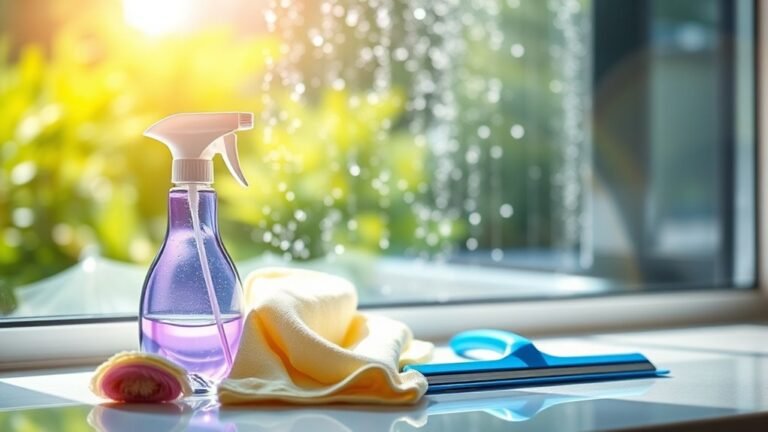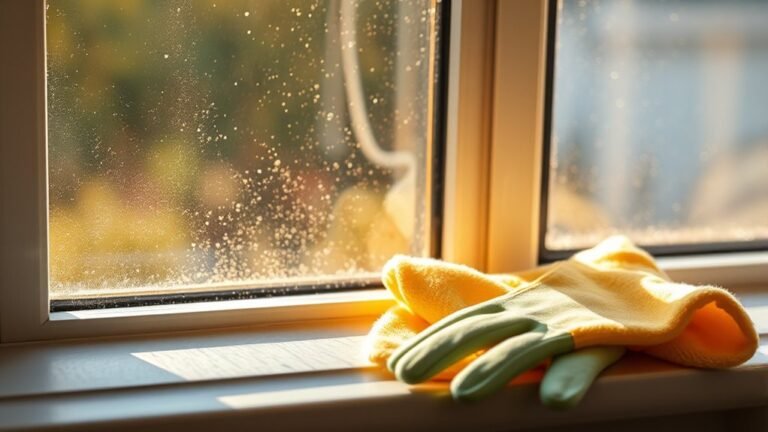Cleaning Tips for Allergy Sufferers: Reducing Dust and Pollen
To reduce dust and pollen in your home, use microfiber cloths and HEPA filter vacuums to trap allergens without spreading them. Dust from top to bottom, and clean often, including ceiling fans and baseboards. Keep windows closed during high pollen times and remove shoes at the door. Improve air quality with proper ventilation and regular filter changes. Don’t forget to wash bedding and soft furnishings frequently with hypoallergenic detergent. There’s plenty more you can do to create a fresher, allergy-friendly living space.
Understanding Common Household Allergens

Although allergens can be found just about anywhere in your home, knowing which ones are most common helps you target your cleaning efforts effectively. You’re likely dealing with common allergens like dust mites, pet dander, mold spores, and pollen that sneak into your living space. These household irritants can trigger sneezing, itching, and congestion, limiting your freedom to enjoy your home fully. Understanding where these allergens thrive — such as in carpets, upholstery, and humid areas — lets you focus your efforts where they matter most. By recognizing these invisible invaders, you’ll take control of your environment and breathe easier without feeling trapped by allergy symptoms. Targeting these common allergens is your first step toward reclaiming a fresh, clean, and free space.
Choosing the Right Cleaning Tools for Allergies
When you’re tackling allergens, picking the right cleaning tools makes all the difference in how effectively you reduce irritants. Start by choosing microfiber cloths—they trap dust and pollen better than traditional fabrics, so you won’t just push allergens around. These cloths are easy to wash and reuse, giving you freedom from disposable options. For floors and carpets, invest in a vacuum designed for allergen vacuuming, equipped with a HEPA filter. This guarantees dust mites, pet dander, and pollen are captured, not released back into your space. Avoid vacuums without proper filtration; they can worsen allergies. By selecting tools that genuinely contain allergens, you create a cleaner, freer environment where you can breathe easier and live without constant irritation.
Effective Dusting Techniques to Minimize Allergen Spread

To keep allergens at bay, you’ll want to pick the right dusting tools that trap dust instead of just moving it around. Using effective dusting methods can prevent allergens from spreading through the air. Plus, knowing how often and when to dust will make a big difference in maintaining a cleaner, allergy-friendly home.
Choosing Proper Dusting Tools
Picking the right dusting tools can make a big difference in reducing allergens in your home. You want tools that trap dust rather than scatter it, giving you the freedom to breathe easier. Microfiber cloths are your best friends—they attract and hold dust without releasing it back into the air. Pair them with gentle dusting sprays to boost effectiveness.
| Tool Type | Benefit |
|---|---|
| Microfiber Cloth | Traps dust, reusable |
| Dusting Spray | Loosens stubborn particles |
| Electrostatic Duster | Captures allergens easily |
| Vacuum with HEPA | Removes dust thoroughly |
Choose tools that help you take control, minimizing allergen spread while keeping cleaning simple and efficient.
Dusting Methods That Work
Using the right dusting tools is only part of the solution—you also need to apply techniques that keep allergens from spreading around your home. Start by gently wiping surfaces with damp microfiber cloths; they trap dust instead of scattering it into the air. Avoid dry dusting, which can send particles floating, worsening allergy symptoms. Work from top to bottom, so dust falls onto areas you’ll clean later, preventing recontamination. Use slow, deliberate strokes rather than quick swipes to capture allergens effectively. Don’t forget less obvious spots like ceiling fans and baseboards. By combining these dusting techniques with microfiber cloths, you gain control over allergens and create a cleaner, freer space that supports your well-being without feeling restrictive.
Frequency and Timing Tips
Although dusting techniques are essential, how often and when you dust can greatly impact allergen control. To keep allergens like dust and pollen at bay, stick to a consistent cleaning schedule that fits your lifestyle without feeling restrictive. Aim to dust at least twice a week, focusing on areas where allergens settle most. The ideal timing is during the late morning or early afternoon when humidity is lower, helping dust particles settle quickly and making your efforts more effective. Avoid dusting when pollen counts are high outside, as this can bring more allergens indoors. By choosing the right moments to dust and maintaining a steady cleaning schedule, you’ll control allergens efficiently while still enjoying the freedom to live your life comfortably.
Strategies for Managing Pollen Indoors

Since pollen can easily make its way indoors, it’s important to take proactive steps to reduce its presence in your home. Start by identifying common pollen sources near your living spaces, like flowering trees or grasses. Keeping windows and doors closed during peak pollen times can prevent unwanted particles from sneaking in. Be mindful with indoor plants—they add life but can also trap pollen and dust, so choose low-pollen varieties and clean leaves regularly. Removing shoes at the door helps stop pollen carried on your footwear from spreading inside. Regularly wiping down surfaces with a damp cloth traps pollen rather than spreading it around. These strategies give you the freedom to enjoy a cleaner, pollen-reduced indoor environment without feeling confined or restricted.
Maintaining Air Quality With Proper Ventilation and Filtration
To keep allergens at bay, you’ll want to improve indoor airflow by opening windows or using exhaust fans when possible. Choosing the right air filters, like HEPA filters, can also capture tiny particles that trigger allergies. These simple steps can make a big difference in the air quality of your home.
Enhancing Indoor Airflow
One of the easiest ways to reduce allergens in your home is by improving indoor airflow. Good air circulation helps sweep away dust and pollen, while proper humidity control prevents mold and dust mites from thriving. You don’t have to sacrifice comfort to breathe easier.
To enhance your indoor airflow, consider these tips:
- Open windows strategically to create cross-ventilation when outdoor air quality is good.
- Use ceiling fans or portable fans to keep air moving consistently throughout your rooms.
- Keep vents and ducts clean and unobstructed for ideal airflow and to avoid trapped allergens.
Choosing Effective Air Filters
Although good airflow is essential, it won’t do much if the air you’re circulating is still filled with allergens. Choosing effective air filters is key to truly freeing your indoor space from dust and pollen. You’ll want to take into account different filter types—HEPA filters are excellent for trapping tiny particles, while activated carbon filters tackle odors and chemical irritants. Pay close attention to filter efficiency ratings; a higher MERV rating means better filtration but can restrict airflow, so find a balance that suits your system. Regularly replacing filters guarantees they keep working efficiently, maintaining fresh, clean air. By selecting the right filter types and monitoring their efficiency, you regain control over your environment, making your home a sanctuary where allergies don’t hold you back.
Regular Cleaning Routines to Keep Allergens at Bay
Since allergens can accumulate quickly, establishing regular cleaning routines is essential for keeping your home comfortable and healthy. You’ll want to create cleaning schedules that fit your lifestyle, so you don’t feel trapped by chores but free to enjoy your space. Focus on allergen hotspots—places where dust and pollen gather fastest. Here’s where to start:
- Vacuum floors and upholstery with a HEPA filter vacuum at least twice a week.
- Wipe down surfaces like shelves, window sills, and blinds using a damp cloth to catch dust instead of spreading it.
- Clean air vents and replace filters regularly to maintain good airflow and reduce airborne allergens.
Tips for Laundering Bedding and Soft Furnishings
When you’re dealing with allergies, laundering your bedding and soft furnishings properly is essential to minimize irritants like dust mites and pet dander. Choosing the right laundry detergent and washing temperatures can make a big difference. Use hypoallergenic, fragrance-free detergent, and wash items in hot water (at least 130°F) to kill allergens effectively. Here’s a quick guide to help you:
| Item | Washing Temperature | Laundry Detergent Tip |
|---|---|---|
| Pillowcases | 130°F (54°C) | Hypoallergenic, fragrance-free |
| Duvet Covers | 130°F (54°C) | Avoid fabric softeners |
| Curtains | Cold to warm water | Use gentle detergent |
| Plush Toys | Warm water | Use allergen-free detergent |
Following these tips frees you from allergy triggers while keeping your home fresh.
Frequently Asked Questions
Can Certain Foods Help Reduce Allergy Symptoms From Dust and Pollen?
Think of your body as a fortress, and your food choices as the soldiers defending it. Certain foods, like citrus fruits, leafy greens, and nuts, can boost your immune support, helping you fight off allergy symptoms from dust and pollen. By choosing nutrient-rich meals, you’re giving yourself the freedom to breathe easy and enjoy life without constant sniffles or sneezes. So, eat smart and take charge of your health!
Are There Specific Plants That Can Worsen Indoor Pollen Allergies?
Yes, you should avoid certain houseplants like flowering plants that release pollen indoors, such as lilies or jasmine, if you’re sensitive. They can worsen your indoor air quality and trigger allergies. Instead, stick to low-pollen plants like spider plants or snake plants, which even help purify the air. Choosing the right plants lets you enjoy freedom from sneezing fits and keeps your space fresh without compromising your health.
How Often Should Air Filters Be Replaced for Optimal Allergy Control?
Just like changing the oil keeps your car running smoothly, regular filter maintenance is key to allergy prevention. You’ll want to replace your air filters every 1 to 3 months to keep indoor air fresh and free of irritants. If you’re living in a high-pollen area or have pets, changing them more often helps you breathe easier. Staying on top of this gives you the freedom to enjoy your space without sneezing or discomfort.
Is Using Essential Oils Effective in Reducing Airborne Allergens?
You might wonder if essential oil blends can help reduce airborne allergens. While they won’t replace thorough cleaning, using diffuser techniques can create a fresher atmosphere by mildly purifying the air and easing allergy symptoms. You’ll want to choose oils like eucalyptus or tea tree for their natural antibacterial properties. Remember, essential oils offer a sense of freedom from harsh chemicals, but they should complement, not replace, other allergy control methods.
Can Pets Contribute to Dust and Pollen Allergies Indoors?
Imagine you’ve just adopted a playful cat, only to find your sneezing and congestion worsen indoors. That’s because pets can definitely contribute to indoor allergens like pet dander, which clings to furniture and fabrics. This dander often mixes with dust and pollen, making your allergy symptoms flare up. To keep enjoying your freedom with pets, regular cleaning and air filtration can help reduce these allergens and keep your space comfortable.






